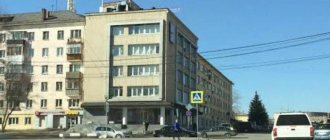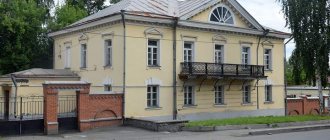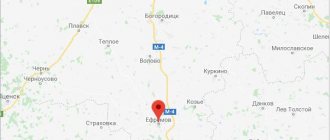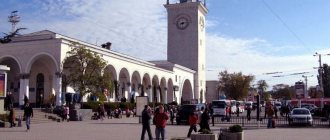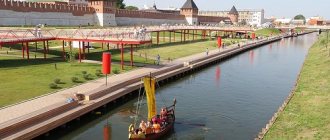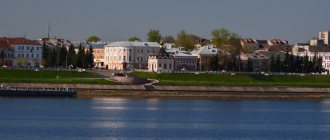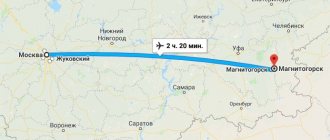Geography
The city is located on the eastern slope of the Ural Mountains, 20-25 km from the conventional border of Europe and Asia at an altitude of 200 m above sea level. The western border of the city runs along the Merry Mountains mountain range of the Urals.
The area of the city of Nizhny Tagil is 298.47 km². The area of the urban district (since April 1, 2008, after the inclusion of 22 towns, villages and villages that voted in a referendum to join) is 4108 km².
To the west of the city lies the main watershed of the Ural Range with individual hills and mountain ranges stretching from north to south. This part of the Main Ural Range is called the Merry Mountains. The average height of the mountains is 400-500 meters, and only a few peaks rise above 700 m - Mount Belaya (712 m), Starik-Kamen (755 m), Shirokaya (746 m). Steep, steep stone peaks - “shikhans”, crowned with rocks - “remnants”, create a unique landscape of the Middle Urals. Right within the city limits there are the Bear-Kamen, Vysokaya mountains with a quarry on the northern slope, Dolgaya with a ski jump complex on the eastern slope, Goly Kamen, Tselovalnikova, Palyonaya, Pikhtovye Mountains, the main symbol of the city, Fox Mountain with a watchtower on the top. To the east of the city, the relief gradually levels out and turns into the West Siberian Lowland.
There are no powerful waterways in the area. The main river, Tagil, with numerous tributaries, flows into the Tura River of the Ob-Irtysh basin. The Tagil pond stretches for 16 km, its greatest width is 1.5 km, and its depth is up to 12 meters. The second big river of Nizhny Tagil is the Vyya. Within the city limits, it is artificially expanded and, like Tagil, is a long elongated pond - Vyisky Pond. Within the city, in the Lebyazhka area, the Vyya flows into the Tagil.
In addition to Tagil and Vyya, 13 rivers and streams flow within the city: Barancha, Rush, Bolshaya Kushva, Malaya Kushva, Leba, Vatikha, Lebyazhka, Vyazovka, Ezhovaya, Galyanka, Rudyanka, Cheremshanka, Prikazchitsa, Olkhovka, Chernaya Katabka.
To this day, the city uses a water supply system developed by the Demidovs.
Climate
Nizhny Tagil is located in a zone of temperate continental climate with characteristic sharp variability of weather conditions and well-defined seasons. The average annual air temperature in Nizhny Tagil is +1.7 °C, the absolute maximum is +37 °C, the absolute minimum is −52 °C.
- Average annual air temperature: 1.7 °C
- Relative humidity: 75.1%
- Average wind speed: 2.5 m/s
Origin of the river's name
The origin of the name is a topic of long-standing debate between historians, linguists and local historians. According to the generally accepted and widespread version, the word “tagil” translated from Vogul means “much water, a lot of water,” but this option is constantly disputed by linguists, who are inclined to two more equally interesting versions.
- The most primitive option: in translation from the Tatar language “tag” is “still”, and “yl” (yul - according to some sources) is translated as “river”. This version is little loved by historians due to its inconclusiveness.
- “Tag” in ancient Turkic means mountain, “el” means homeland or country. That is, initially Tagil was not a river, it was a mountainous country, and the name of the area determined the name of the river in the future.
- There is a Kazakh translation: “tagyly” is an area with wild animals, or a place rich in game.
Only long-dead ancestors know which of the translation options is valid, but all versions have their own reason and hidden meaning.
Story
At the end of the 16th century, Ermak Timofeevich arranged a camp for his troops in the vicinity of the city, near Mount Bear-Stone, thereby crossing the European-Asian divide.
In 1696, in the area of Mount Vysokaya, and in 1702, along the banks of the Vyya River, copper ore was found by the boyar’s son Mikhail Bibikov. The year 1696 is considered the beginning of the city's history. In 1714, the then owner of the Ural factories, Akinfiy Demidov, was informed about the mines; soon after, by decree of Tsar Peter I, he founded the Tagil and Vyisky ironworks and the production of cast iron, iron and copper began in the Urals. Ore was taken from the Vysokogorsky, Lebyazhinsky and Ivanovsky iron mines. In 1737, copper ore was discovered along the banks of the Lebyazhka River.
October 8 (19), 1722 is considered the date of foundation of Nizhny Tagil, when the first product - cast iron - was produced at the Vyysky plant. Founded by the Demidov dynasty, which before the revolution owned the Tagil factories: “Verkhne-Vyisky” and “Tagilsky”. At this time, the products of Tagil iron and copper smelting plants, known under the trademark “Old Sable,” became world famous. The legend about the use of Tagil copper in the creation of the Statue of Liberty has not yet found documentary evidence.
Nizhny Tagil is also widely known in Russia for its folk craft of Tagil painting of tin trays. In 1833, in Nizhny Tagil, serf inventors father and son Cherepanovs (Efim Alekseevich and Miron Efimovich) built the first steam locomotives in Russia. According to legend, in 1800, serf mechanic Efim Artamonov made the world's first bicycle with pedals and steering.
In 1918, major battles took place in Nizhny Tagil during the Civil War. They were very fierce and lasted from September 9 to October 22, 1918. 10 thousand Red Army soldiers and six thousand White Guards took part, on whose side were also the Czechoslovaks. It has been established that in total about 400 Czechoslovak legionnaires died in the battles for Nizhny Tagil. In November 2009, a monument to the Czechoslovak legionnaires who fell there was opened in Nizhny Tagil. There are 67 names of soldiers on the monument that were identified.
Nizhny Tagil received city status on August 20, 1919 by decree of the Yekaterinburg Military Revolutionary Committee:
| The Nizhny Tagil plant will be transformed into the city of Nizhny Tagil, without a district, with the introduction of municipal utilities <…> The city of Nizhny Tagil merges into one whole from the Tagil, Vyysko-Nikolsk, and Troitsko-Alexandrovskaya volosts. |
In 1926, five clubs and eight libraries operated in the city, and the first radio center appeared. In 1930, 42 thousand people lived in the city, its housing stock barely exceeded 220 thousand m², 94 percent of the houses were wooden, 85 percent were one-story. The city had 19 primary schools, two technical schools, a workers' school, two cinemas, two hospitals with a total number of beds of 126. There was no running water or sewerage.
In 1932, construction of the first workshops of the Ural Carriage Plant began. Four years later, in October 1936, the first freight car rolled off its assembly line. In 1937, the first tram was launched in Nizhny Tagil. In 1939, a teacher's institute was opened - the city's first higher education institution.
During the Great Patriotic War, the majority of all T-34 tanks produced were produced at Uralvagonzavod, where eleven enterprises in the western part of the USSR were evacuated.
At the end of the 1930s. The All-Union Association "Steel" ordered Gipromez to begin designing the Novo-Tagil Metallurgical Plant. On September 1, 1930, a decree of the Council of People's Commissars of the USSR was issued, obliging the Supreme Agricultural Sciences and the State Planning Committee of the USSR to begin construction of NTMZ. On March 17, 1931, on Fedorina Gora, near the Vyazovka River, the first barracks appeared at the construction site, where the construction headquarters was located. In 1932, the plant construction department was already located in three barracks. By 1935, a water supply workshop was built at the NTMZ plant, and construction of a thermal power plant and open-hearth and bandage shops began. In 1936, the first open-hearth furnace was laid. In January 1938, a motor transport shop began operating, and in April of the same year, a network and substations shop opened, and in May, a mechanical and shaped foundry shop. On April 25, 1940, the plant's thermal power plant produced its first current, and on June 17, the coke-chemical workshop began operating; On June 25 of the same year, the first blast furnace produced the first cast iron, and on September 23, the second open-hearth shop was opened; On December 11, the second blast furnace was launched. In the same year, the VZhR processing plant was built at the Vysokogorsky mine; iron ore production in 1940 was 744,000 tons. In 1941, the third blast furnace was launched at NTMZ, and at the Refractory Plant, the technology of steel-casting supplies was mastered for the first time in the Urals. During the Great Patriotic War, ferrochrome production was mastered at the old Demidov Metallurgical Plant (named after Kuibyshev). The NTMZ rolling shop began production of armor plates for the needs of the front, and ferrosilicon was launched in the blast furnace shop. In February 1942, the production of shells for front-line Katyushas was mastered. On April 25 of the same year, the fourth blast furnace was launched at NTMZ. In 1943, the boiler-assembly shop began work, the fifth and sixth blast furnaces were launched; the third coke battery and tar distillation shop began operating at the coke-chemical production, and at VZhR a magnetic enrichment factory and a Hoffmann furnace (at OGZ) began operating. In 1944, an iron foundry, a forging shop and an instrumentation shop were built at NTMZ, and new batteries were launched at Koksokhim. In 1945, blast furnace repair and steam power shops were launched.
During the years of the Great Patriotic War, 4,278,000 tons of steel were smelted at the New and Old metallurgical plants of Nizhny Tagil, and 532,000 tons of rolled metal were produced. During the war years, NTMZ produced about 30% of all armored steel in the USSR. More than 13 million tons of raw ore were mined at VZhR; About 8 million tons of marketable ore were produced.
The importance of Nizhny Tagil is also evidenced by the fact that it was included in the number of 20 cities of the USSR subject to atomic bombing, according to the first post-war plan for the war against the USSR (Plan “Totality”), developed in the USA already in 1945, and was also included in subsequent similar plans.
On February 1, 1963, the Council of Workers' Deputies of the city of Nizhny Tagil was transferred to the subordination of the Sverdlovsk Regional Council of Workers' Deputies.
Coat of arms (1995—2005)
On February 1, 1971, Nizhny Tagil was awarded the Order of the Red Banner of Labor “for the successes achieved by workers in fulfilling the tasks of the five-year plan for the development of industrial production, especially the ferrous metallurgy and mechanical engineering industries.”
Since the early 1990s. The main battle tank T-90 (manufactured by Uralvagonzavod) is produced in the city.
Administrative-territorial structure
Main article: Administrative division of Nizhny Tagil
Local government
The structure of local government bodies of the city is:
- Nizhny Tagil City Duma
- Head of the city of Nizhny Tagil
- Administration of the city of Nizhny Tagil
- Accounts Chamber of the city of Nizhny Tagil
State power in the city is exercised on the basis of the Nizhny Tagil City Charter, which was adopted by the Nizhny Tagil City Duma on November 24, 2005. The highest official is the head of the city, elected by citizens of the Russian Federation living in the territory of Nizhny Tagil and having, in accordance with federal law, active voting rights, on the basis of universal equal and direct suffrage by secret ballot for a period of 5 years.
On May 28, 2022, the head of the city, Sergei Nosov, was appointed acting governor of the Magadan region by decree of President Vladimir Putin. The first deputy head of the Nizhny Tagil City Administration, Vladislav Pinaev, became the acting head of the city.
Executive power in the city is exercised by the Administration of the city of Nizhny Tagil, headed by the head of the city, and other executive bodies of state power of Nizhny Tagil. The city administration is located in a building on Parkhomenko Street.
Legislative power in the city is exercised by the Nizhny Tagil City Duma, consisting of 28 deputies elected by city residents according to a mixed system for a period of 5 years. In September 2022, the Duma of the seventh convocation was elected. The Chairman of the Nizhny Tagil City Duma is Alexey Pyrin.
To organize and monitor the execution of the city budget and the expenditure of extra-budgetary funds, the Accounts Chamber of the city of Nizhny Tagil was created.
City
Nizhny Tagil is divided into three intra-city districts:
- Tagilstroevsky;
- Leninist;
- Dzerzhinsky.
City districts are not municipalities.
Suburb
As part of the urban district (municipal entity) of the city of Nizhny Tagil, in addition to the city itself, there are also 23 rural settlements. Two of them are subordinated directly to district administrations (the village of Evstunikha is the administration of the Leninsky district, and the village of Zaprudny is the administration of the Tagilstroevsky district). The remaining rural settlements of the urban district are distributed between seven territorial administrations.
Links
- Official information server of the city of Nizhny Tagil
- History of the coat of arms of Nizhny Tagil
| Cities of the Sverdlovsk region | |
| Administrative center: Ekaterinburg Alapaevsk | Aramil | Artyomovsky | Asbestos | Berezovsky | Bogdanovich | Verkhniy Tagil | Verkhnyaya Pyshma | Verkhnyaya Salda | Verkhnyaya Tura | Verkhoturye | Volchansk | Degtyarsk | Zarechny | Ivdel | Irbit | Kamensk-Uralsky | Kamyshlov | Karpinsk | Kachkanar | Kirovgrad | Krasnoturinsk | Krasnouralsk | Krasnoufimsk | Kushwa | Lesnoy | Mikhailovsk | Nevyansk | Nizhniye Sergi | Nizhny Tagil | Nizhnyaya Salda | Nizhnyaya Tura | New Lyalya | Novouralsk | Pervouralsk | Polevskoy | Revda | Dir | Severouralsk | Serov | Sredneuralsk | Sukhoi Log | Sysert | Tavda | Talitsa | Turinsk |
